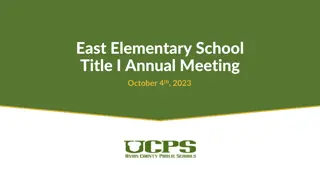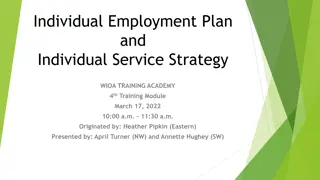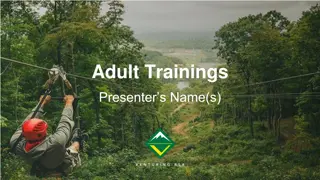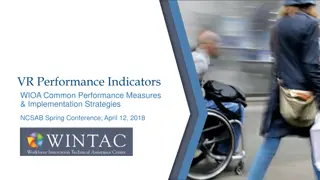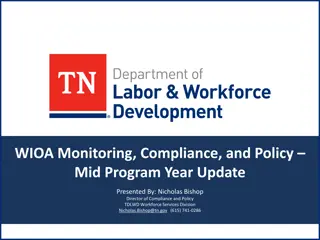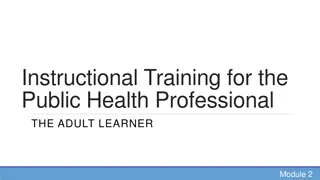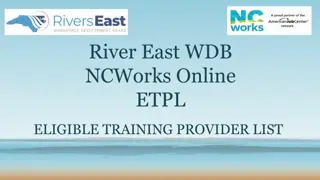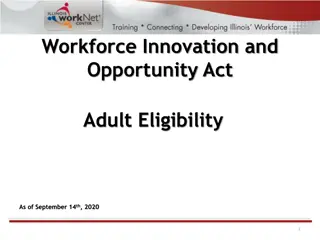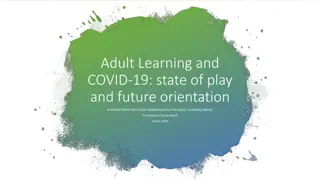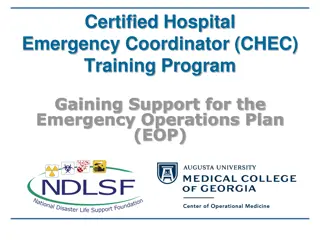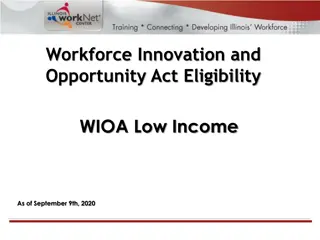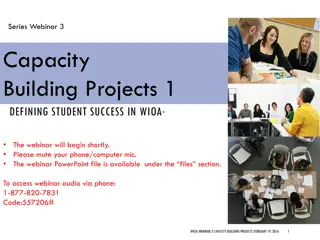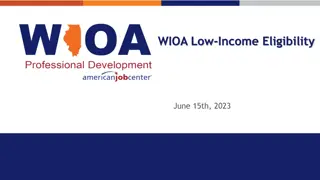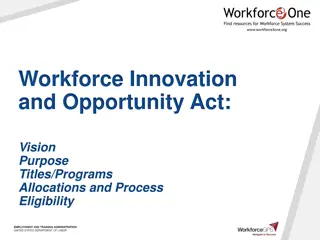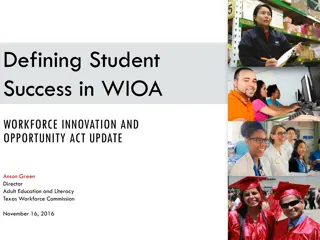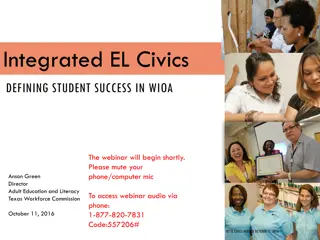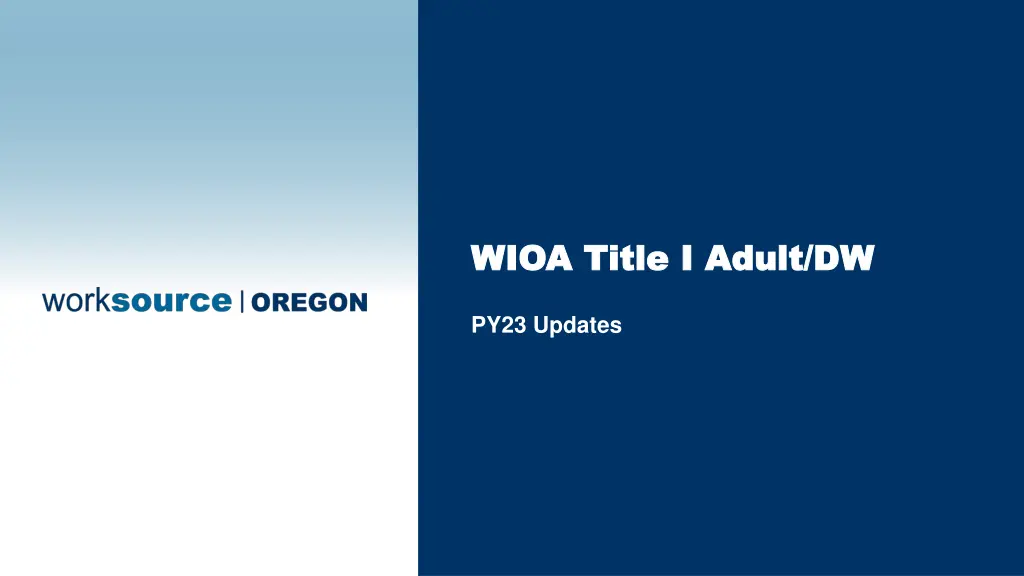
Oregon Workforce Partnership Changes in WIOA Title-1 Enrollment Requirements
Read about the updates made by the Oregon Workforce Partnership to comply with new data validation requirements for enrollment into WIOA Title-1 services. Changes include modifications in registration processes, eligibility determination, and follow-up services to meet WIOA program standards.
Download Presentation

Please find below an Image/Link to download the presentation.
The content on the website is provided AS IS for your information and personal use only. It may not be sold, licensed, or shared on other websites without obtaining consent from the author. If you encounter any issues during the download, it is possible that the publisher has removed the file from their server.
You are allowed to download the files provided on this website for personal or commercial use, subject to the condition that they are used lawfully. All files are the property of their respective owners.
The content on the website is provided AS IS for your information and personal use only. It may not be sold, licensed, or shared on other websites without obtaining consent from the author.
E N D
Presentation Transcript
WIOA Title I Adult/DW WIOA Title I Adult/DW PY23 Updates
Background In June 2020, the US Department of Labor released TEGL 23-19, where new data validation requirements were outlined for enrollment into WIOA Title-1 services. As a result of the new requirements, all nine Local Workforce Development Boards in Oregon collaborated to review and explore solutions to address the new requirements. Training Agenda Training Agenda Overview of Changes WIOA Adult Eligibility WIOA DW Eligibility & Dislocation Types WIOA Adult Priority Populations Documentation & Registration New Data Collection Follow-up & Planned Exit Transition Subtitle As a result of this review, in 2021, the Oregon Workforce Partnership approved changes to modify registration processes to be in compliance with WIOA Title-1 and implement follow-up services.
Overview Overview 3
WSO Customer Registration WSO Customer Registration system will no longer determine WIOA program eligibility and will only be required to establish a Job Seeker ID. Some questions in WSO Customer Registration are also changing. Eligibility Responsibility Since WSO Customer Registration system is no longer determining WIOA program eligibility Worksystems and their subcontractors are now responsible for Adult and DW eligibility determination. What s What s Changed Changed Legal to Work WIOA eligibility will no longer require a participant be legal to work to receive program services. It will be important to review this status to meet the employment placement performance. 4
Other Pre-Enrollment Steps iMatchSkills will not be required to enroll into WIOA. This may be needed before engaging with OED programs or some Worksystems programs like On-the-Job Training. WOMIS DOB Validation and WOMIS Welcome Conversation will not be required to enroll. What s What s Changed Changed WIOA Title I Adult/DW Manual Enrollment Decisions TheEconomic Opportunity Program (EOP) only has WIOA Adult funds so can only enroll in WIOA Adult. WorkSource Portland Metro (WSPM) has both WIOA Adult and DW funds so can enroll in both based on the customer s eligibility and what fund is being used to pay for the customer s services. 5
Priority of Service Basic Skills Deficient Added the ability to track basic skills deficient status. Other I-Trac Registration & Documentation Updates There are some new data elements that need to be captured for registration and some documentation requirements have changed. What s What s Changed Changed Disability Program Co-Enrollment For individuals who self-identify they are a person with a disability, there are additional data collection elements related to enrollment into other publicly funded programs. Follow-up & Planned Exit WIOA Follow-up services are now required to be offered for participants placed into employment and available for other participants that may need limited assistance post-exit. 6
WSO Customer Registration questions have changed. Disability Types updated US Citizen or Non-Citizen Legal to Work is not required to complete WSO Customer Registration. Single Parent updated Foster Care System question added New specific Veteran program questions added. Long-term Unemployment question is new. Cultural Beliefs is new. Dislocated Worker questions have been removed. What s What s Changed Changed 7
I-Trac will now contain all the required reporting and documentation elements for enrollment in WIOA Adult. Due to this the WIOA Eligibility Documentation Checklist is no longer a required form but is now a guide to help with eligibility determination and enrollment. What s What s Changed Changed The checklist can help guide the enrollment conversation with the customer to help identify eligibility elements and documentation that a customer may have to provide before starting an enrollment. 8
Eligibility Eligibility 9
WIOA Title I Eligibility Adult Age 18+ In compliance with Selective Service Economic Opportunity Program providers only have WIOA Adult funds in their contract therefore they are only allowed to enroll customers in WIOA Adult. Legal to work is no longer required 10
WIOA Title I Eligibility Dislocated Worker In compliance with Selective Service Has a qualifying dislocation from employment When a participant goes to a WorkSource Center to receive funding for a Training they may need to enroll them in DW at that point in time. This will entail Center staff asking additional questions of the participant and signing the I-Trac Application for the DW enrollment which is separate from the Adult enrollment. Legal to work is no longer required Age is not a factor. I-Trac has minimum age = 14 11
While EOP providers cant enroll a customer in DW the Dislocated Worker types are still a required reporting element to the Department of Labor and are data points in the Adult record therefore EOP providers must understand the definitions. Qualifying Qualifying Dislocation Dislocation Types Types 1. Displaced Homemaker 2. Business Closed or had a Substantial Layoff 3. Military Spouse 4. Self-Employed and Business Closed 5. Separating Service Member 6. Terminated or Laid-off Worker 12
1. Displaced Homemaker 1. Displaced Homemaker One of the following are true: The applicant has been providing unpaid services to their family in the home who has been dependent on the income of another family member but is no longer supported by that income and is unemployed or underemployed and is also experiencing difficulty in obtaining or upgrading employment. OR the applicant has been providing unpaid services to their family in the home who is the dependent spouse of a member of the Armed Forces on active duty whose family income is reduced because of a deployment, activation, relocation, or service-connected disability or death and is unemployed or underemployed and is also experiencing difficulty in obtaining or upgrading employment. 13
1. Displaced Homemaker 1. Displaced Homemaker Underemployed is defined as: The person is employed less than full-time and is seeking full-time employment. The person is employed in a position that does not match their skills and training. The person is employed but their family annual income is lower than the higher level of the poverty line or 70 percent of the LLSIL. The person is employed, but their current income is lower than their previous job s income. 14
2. Business Closed or had a Substantial Layoff 2. Business Closed or had a Substantial Layoff Defined as any one of the following: Business closed due to permanent closure OR Business experienced a substantial layoff (defined as 10 or more people) OR Business announcement of closure within 180 days 15
3. Military Spouse 3. Military Spouse Defined a one of the following: Employment loss due to relocation. OR Difficulty obtaining or upgrading employment as a military spouse. 16
4. Self 4. Self- -Employed and Business Closed Employed and Business Closed Defined as one of the following: Closed due to general economic conditions. OR Closed due to natural disaster. 17
5. Separating Service Member 5. Separating Service Member Is separating from the military and entering civilian labor force. 18
6. Terminated or Laid 6. Terminated or Laid- -off Worker off Worker One of the following is true when the customer has already been terminated or laid-off or has a notice to be terminated or laid off: Eligible for or exhausted UI and unlikely to return to their previous industry or occupation. OR was employed for at least 3 months but is not eligible for UI due to not enough earnings or having worked for an employer not covered by the State UI law and is unlikely to return to their previous industry or occupation. See next slide for unlikely to return to previous industry or occupation definition 19
6. Terminated or Laid 6. Terminated or Laid- -off Worker off Worker *unlikely to return is defined as one of the following Negative economic conditions onthe industry or occupation (e.g., pandemic or natural disaster impacts). Declinein the person s occupation in the labor market. Significant barriers to employment, such as criminal background, lack of high school diploma or GED, disability, homelessness, cultural or language barriers, older worker (55+) or deficient in basic skills. Previous industry or occupation has been eliminated or the person has been unable to secure a position at the same income level as their previous position. Exhausted their unemployment benefits and have been unable to find a job in their previous industry or occupation. Seasonally employed and unlikely to return because of automation of the position or a significant change in normal seasonal employment patterns. 20
Enrollment & Services Flow in I Enrollment & Services Flow in I- -Trac Trac 21
Enrollment Enrollment & Services & Services Flow Flow 22
Providers Tab - ADD Enrollment(s) 1. Staff will manually ADD Adult enrollments. EOP providers are to use their own organization as the Adult provider and not a WorkSource Center provider. Enrollment Enrollment & Services & Services Flow Flow 2. Customers may be co-enrolled in Adult and DW. WSPM staff may enroll a participant in DW after a EOP provider has enrolled them in Adult. 3. If a customer comes to EOP from a WSPM referral they may be enrolled in DW. At that point, the EOP provider must then enroll them in Adult. 4. After the first WIOA record is added, if a second WIOA enrollment is added it will import details from the first record making data entry faster. 5. Where staff are enrolling a customer who is already enrolled in another local Workforce Board area, the data will import from that record. If that record is active, you are accepting that local area s documentation and eligibility results. 23
New Registration Data Collection New Registration Data Collection & Definitions & Definitions 24
New New Registration Registration Data Data Collection & Collection & Definitions Definitions Sex and Gender Identity Wherever Sex (at birth) is collected, Gender (Identity) will also be collected. Self-identified. Sex (Assigned at Birth) Male Female Not Disclosed Gender (Identity) Man Woman Nonbinary or Genderqueer Not Disclosed 25
Social Security Number Consent to Disclose Because I-Trac may have a participant s SSN on record, it does not mean they have consented to our use of this number. For every new enrollment period: New New Registration Registration Data Data Collection & Collection & Definitions Definitions 1. Each participant must receive and have discussed with them the SSN Disclosure Statement 2. The SSN must be in I-Trac and staff will inform the customer s consent to use. 3. Staff should know and understand how it is used and that it is encrypted once entered in the system. 4. The SSN is only shared through secure protocols with third parties for performance related crossmatching. 26
Employment Statuses We ask whether the customer is: Employed Not Employed Has Received a Notice of Layoff or Termination Not in the Labor Force New New Registration Registration Data Data Collection & Collection & Definitions Definitions Work History Funders would like to know if the participant has work history and if so, they want to know the following: Most Recent Occupation (ONET) Industry (NAICS) Q1 Before Application Industry (NAICS) Q2 Before Application Industry (NAICS) Q3 Before Application 27
Unemployment Insurance Status The following are new data points and documentation for some must be made in iMatchSkills. New New Registration Registration Data Data Collection & Collection & Definitions Definitions Claimant (not referred by RESEA)- Signed Application. Exhaustee- iMatchSkills Exempt from job search requirements- Signed Application. Not a Claimant or Exhaustee- iMatchSkills 28
Unemployment Insurance Status iMatchSkills New New Registration Registration Data Data Collection & Collection & Definitions Definitions 29
New Youth Related Characteristics There are a few new youth specific data points, where customer s age is under age 25. New New Registration Registration Data Data Collection & Collection & Definitions Definitions Foster Care Youth (Aged Out) Foster Care Youth (Current) Free or Reduced Lunch Eligible (Youth) 30
Six-Month Family Income New New Registration Registration Data Data Collection & Collection & Definitions Definitions Income under WIOA is calculated based on family size while in EOP it is calculated based on household size. They are different definitions. Family is defined as those living in the home and related by blood, marriage, or decree of court. Household is defined as individuals who reside in the home and form one economic unit for purposes of tenancy or homeownership, regardless of whether they are legally related. 31
WIOA Low Income Six-Month Income Determination = Below Family Income Level OR has at least one of the following characteristics: One of these Public Assistance Characteristics Received General Assistance in the last 6 months Received Refugee Cash Assistance in the last 6 month Received SNAP in the last 6 months Received Supplemental Security Disability Income (SSDI) in the last 6 months Received Supplemental Security Income (SSI) in the last 6 months Received TANF in the last 6 months OR Homeless (Includes Runaway Youth) characteristic exists OR Foster Care Youth (Current) characteristic exists OR Free or Reduced Lunch Eligible (Youth) New New Registration Registration Data Data Collection & Collection & Definitions Definitions Note: Low income in EOP is different and is just 50% of the Median Family Income (MFI) for Portland Metropolitan Statistical Area for the participant s household size. 32
WIOA Adult Priority Populations WIOA Adult Priority Populations 33
WIOA Adult Priority Populations Department of Labor has established priority populations to provide services to certain populations. Where two people are candidates for the same service and resources are limited, the priority will be given to the person from a priority population. Priority Populations and related documentation can be updated in I-Trac after Registration if the participant s circumstances change. Refer to the Regional Program Standards for guidance. 34
WIOA Adult Priority Populations Level 2 Priority Low Income, Receiving Public Assistance, or Basic Skills Deficient1 AND Non-Veteran or Veteran Eligible Spouse Level 1 Priority Veteran (Not Dishonorable) or Veteran Eligible Spouse AND Low Income or Basic Skills Deficient1 Level 4 Priority Anyone enrolled Level 3 Priority Veteran (Not Dishonorable) or Eligible Spouse 1 Basic Skills Deficient is new data collection 35
WIOA Registration Documentation WIOA Registration Documentation 36
WIOA Registration Documentation Documentation is the act of proving a particular status. The majority of the data collected at the time of registration is self-attested by the customer when signing the I-Trac application. With the exception of Selective Service when an element cannot be documented at the time of registration, staff cannot choose yes to the element in I-Trac. If documentation is then obtained later this can be updated after registration and a Registration Note added to the record, so the customer does not need to re-sign the application. Refer to the Regional Program Standards for required documentation elements. All required documentation for eligibility must be uploaded to I-Trac, including priority of service. 37
Documentation | Eligibility Date of Birth Public Assistance Benefits Letter Public Assistance Crossmatch School Record or ID Card Selective Service Registration Acknowledgement Letter Selective Service Registration Card Signed Application 1 Tribal ID Card Baptismal Record Birth Certificate DD-214 Military Separation Record Driver s License Family Bible Government Issued Photo ID Hospital Record of Birth Justice System Record Medical Record Passport (US) Passport (Foreign) Applicant attestation documented with the signed application may only be used when the applicant does not have one of the allowable birthdate validation documents available. When applicant attestation is used for date of birth documentation, it is required that securing documentation necessary to complete employment (I-9) documentation be part of the service plan. 38
Documentation | Eligibility Selective Service Requirement to Register Required Reasons I was sex-assigned male at birth AND I am a US Citizen OR immigrant residing in the US between the ages of 18 and 25 AND are age 18 or older AND were born on or after January 1, 1960 Status Registered Documentation Types by Status Selective Service Registration Acknowledgement Letter Selective Service Registration Card Selective Service Stamped Post Office Receipt of Registration Not Registered I was unaware of the requirement to register and I am over the age of 25. Request for Status Information Letter & Supporting Documentation Selective Service Status Information Letter Not Registered I willingly and lawfully chose not to register Not Registered - I am between the ages of 18 and 25 and have not yet registered. Will not be eligible Must Register to be eligible. 39
Documentation | Eligibility Selective Service Not Required to Register/Exempt Not Required/Exempt Reasons Status 1. I was sex-assigned female at birth 2. OR I was born before 1960 3. OR I am under the age of 18 4. OR I am a seasonal agricultural worker on a H-2A visa 5. OR I am a lawful non-immigrant on a current non- immigrant visa 6. OR I was incarcerated/hospitalized/institutionalized continuously between my 18th and 26th birthdays 7. OR I was not living in the United States between my 18th and 26th birthdays 8. OR I was on active US Military, Coast Guard duty or a student in an Officer Procurement Program continuously between my 18th and 26th birthdays Documentation Types by Status Signed Application (Age/Sex at Birth) Military Separation Record (DD-214) Immigrant/Non-Immigrant Allowable Documents Record of incarceration, hospitalization, or institutionalization Not Required to Register 40
Documentation | Priority Population Veteran & Eligible Spouse Military Separation Record (DD-214) Veteran Affairs Letter Veterans Crossmatch (Department of Defense) Veterans Crossmatch (Veterans Services System) Signed Application1 1 Signed Application is not enough for WIOA Adult Prioritization of Services must obtain a document. 41
Documentation | Priority Population Public Assistance Public Assistance Types Is exhausting TANF within 2 years Receiving SNAP Received Supplemental Security Disability Income (SSDI) in the last 6 months Received Supplemental Security Income (SSI) in the last 6 months Received TANF in the last 6 months Received General Assistance in the last 6 months Received Refugee Cash Assistance in the last 6 months Documentation by Public Assistance Type Public Assistance Benefits Letter Public Assistance Crossmatch Public Assistance Referral From Agency Public Assistance Benefits Letter Public Assistance Crossmatch Public Assistance Referral From Agency Public Assistance Check Copy Public Assistance Medical Card Received SNAP in the last 6 months is collected for Low Income priority, but is not a type that sets the Public Assistance Priority Population. 42
Documentation | Priority Population Basic Skills Deficient Staff Attest to this element where a customer is basic skills deficient. By being logged into I-Trac and saving data, staff indicate and attest to their assessment. Below are the allowable options to assess this: Is enrolled in Adult Education or ESL classes Limited English Skills- Assessment through staff engagement and observation 43
Documentation | Priority Population Basic Skills Deficient Staff Observation-Staff make observations of deficient functioning in completing forms, assisting in the development of a service strategy, or behaviors in group discussion settings. GPA at D or below within the previous six months. Qualifies for Special Education services or has an IEP Plan 44
Documentation | Other Unemployment Insurance Status Documentation by UI Status Signed Application Unemployment Insurance Statuses Claimant Not Referred by RESEA Exhaustee Exempt from job search requirements Not a claimant or Exhaustee Crossmatch to MIS Database (iMatchSkills) 45
Documentation | Application An Application has been added to the enrollment process for Adult and DW similar to what we already have in many of Worksystems Discretionary grants. The signed Application is used for documentation for eligibility elements that can be self attested. Preference is to use the I-Trac eSignature tool to obtain the customer signature. If this tool is not possible to use the Application must be printed, signed and uploaded to I-Trac. The signature statement now includes a Participation and Information Sharing Agreement. This agreement is used to collect the customer s authorization to release their information with WIOA partners. 46
Documentation | Application The signature statement is four pages. It is important for staff to view this statement before it is being given to customers to sign so they are familiar with the contents. Worksystems will send out a copy of this to review. We translated the statement into five languages: Simplified Chinese, Traditional Chinese, Vietnamese, Russian and Spanish. 47
Disability Program Co Disability Program Co- -Enrollment Enrollment 48
Where a customer self reports they are a person with a disability at registration, a new tab will appear in I-Trac. On this tab there are four new controls. Disability Disability Program Co Program Co- - enrollment enrollment 1. 2. 3. 4. Programs Financial Capability Services Customized Employment Services Work Setting 49
Programs The funder would like to know if the customer is engaged with one of the following three types of programs: A. State Developmental Disabilities Agency (SSDA) Oregon Health Authority Community Health Programs Behavioral Health Service B. Local or State Mental Health Agency (LSMHA) C. State Medicaid HCBS Waiver Disability Disability Program Co Program Co- - enrollment enrollment If the customer works with one or more of these agencies, staff should get a release of information and coordinate program services. The services funded by the other programs are tracked in the next three controls. 50

